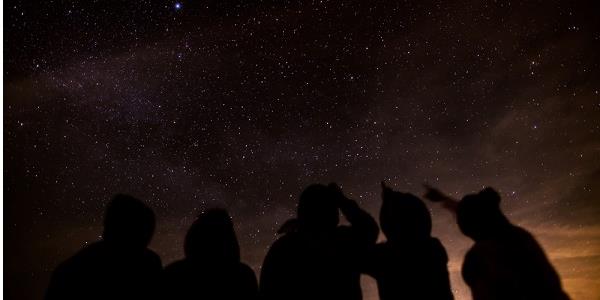
Stargazing is perhaps one of the most universal hobbies available. All you need is the ability to look up and access to the night sky, and you’re ready to go. However, how many of us have actually taken the time to really appreciate the stars above our heads?
If you’re enjoying a stay at the Kings Arms Hotel, you’re in the perfect position to change this. The Yorkshire Dales National Park is one of the best places in the UK for admiring the grandeur of the night sky. With no city lights to distract, the skies are beautifully dark – ideal for both beginner stargazers and practiced experts.
Where to go
The whole of the Yorkshire Dales provides fantastic opportunities for stargazing, but for the best experience we would recommend using one of the four Dark Sky Discovery Sites dotted throughout the park. Awarded official status by the Science and Technology Facilities Council (STFC), there are over 100 Dark Skies Discovery Sites throughout the UK. They are perfect for observing the sky on a clear night, with barely any light pollution and great sightlines in all directions.
Out of all the Dark Sky Discovery Sites in the Yorkshire Dales, the Hawes National Park Centre is closest to the Kings Arms (just a 10-minute drive down the A684). You could also visit the Malham National Park Centre, Buckden National Park Car Park and Tan Hill Inn. Like all Dark Sky sites, these areas are all open to the public, have good accessibility and provide facilities such as parking, making them ideal for visitors to the area.
What to look for
If you’re lucky enough to visit the National Park on a clear night, you could see up to 2,000 stars shining overhead. When it comes to identifying them, it’s easy to be overwhelmed. Fortunately, technology is on our side. There are many mobile apps which you can use to navigate the night sky – Google Sky Map and Star Walk are great examples. Alternatively, you can’t go far wrong with a good old star chart! One good rule to remember is; if it sparkles, it’s a star. If it’s steady, it’s a planet.
The Milky Way is also visible from most of the Park, especially during the Autumn and Winter months. This spectacular view of our home galaxy is perhaps one of the most beautiful spectacles of the night sky, but is most obvious at its core, located in the constellation Sagittarius. Star clusters, dust lanes and nebulas are all found in this area, and give the appearance of an awe-inspiring ‘cloud’ of stars reaching across the sky.

The International Space Station orbits the Earth every 90 minutes and is often visible overhead. You can find out when the station is due to travel across the skies using NASA’s Spot the Station tool. Look up and try to spot a bright, rapidly moving point of light travelling from West to East.
Meteors also provide a real treat to stargazers at the Yorkshire Dales. These fragments of asteroids or comets burn up as the enter the Earth’s atmosphere, creating the fiery trails we know so well. You can see Meteors every night, but at certain times each year a shower of meteors will arrive at once. This happens as Earth passes through the remnants of a comet that passed long ago, and makes for a truly spectacular show.

Last but certainly not least, you don’t have to travel all the way into the Arctic circle to witness the magic of the Northern Lights – they’ve been spotted in the Yorkshire Dales. There are several websites which predict when the lights might appear, although they generally only make predictions a few hours in advance. Don’t be too disappointed if you don’t spot them, though – the Northern Lights are famously elusive.

Some hints and tips
If you’re planning your first stargazing adventure during your trip to the Yorkshire Dales, we’ve put together a few hints and tips to make your trip as successful as possible.
-
Check the phase of the moon before you go. Stargazing is best during the new moon.
-
Bring something to sit or lay on, warm clothing and blankets. Clear nights may be the best for stargazing, but they can get very cold. A warm drink will also go down well!
-
Binoculars are great if you want to get a closer look at anything, but you can see plenty with the naked eye.
-
It takes your eyes 15 to 20 minutes to see their best in the dark, so be patient as you adjust. Try to avoid looking at any bright lights while you wait.
-
If you need a light to help you find your way, try a torch with a red filter. Red light does not have the same effect on eyes as does blue or white light, and shouldn’t affect your ability to see the stars. You can create your own by covering a normal torch with red cellophane or paper.

Discover more
If you’re after an expert guide to help you discover the night sky, the Yorkshire Dales occasionally hold stargazing workshops. Led by their rangers, you’ll enjoy a night time walk where you can discover all the heavens have to offer. These tours are weather dependant, and you can find the dates on the Yorkshire Dales website.
Another event not to be missed is the annual Dark Skies Festival. This is a joint event run between the Yorkshire Dales, Northumberland, North York Moors and South Downs National Park. Working with local astronomy clubs and other organisations, it involves events for families, beginners and those wishing to expand their skills. Activities include stargazing events, dark skies photography workshops and night cycle rides and walks. For more information, make sure to take a look at their website.

Once you’re hooked (and we’re sure you will be), you’ll be ready to expand your horizons further; perhaps with a trip to the Kelder Observatory, which is located in the Northumberland International Dark Sky Park, just a few miles from Lucker Hall.
To quote Douglas Adams, “Space is big. You just won't believe how vastly, hugely, mind-bogglingly big it is.” The Yorkshire Dales are a fantastic place to really begin to appreciate it. Free from the light pollution that so many of us are used to, the endless dark sky provides the perfect backdrop for the universe’s awe-inspiring show.
The Kings Arms is perfectly located for getting out and exploring this beautiful part of the UK. Get in touch to find out more about how you can visit this property, as well as the rest of HPB’s great locations.

